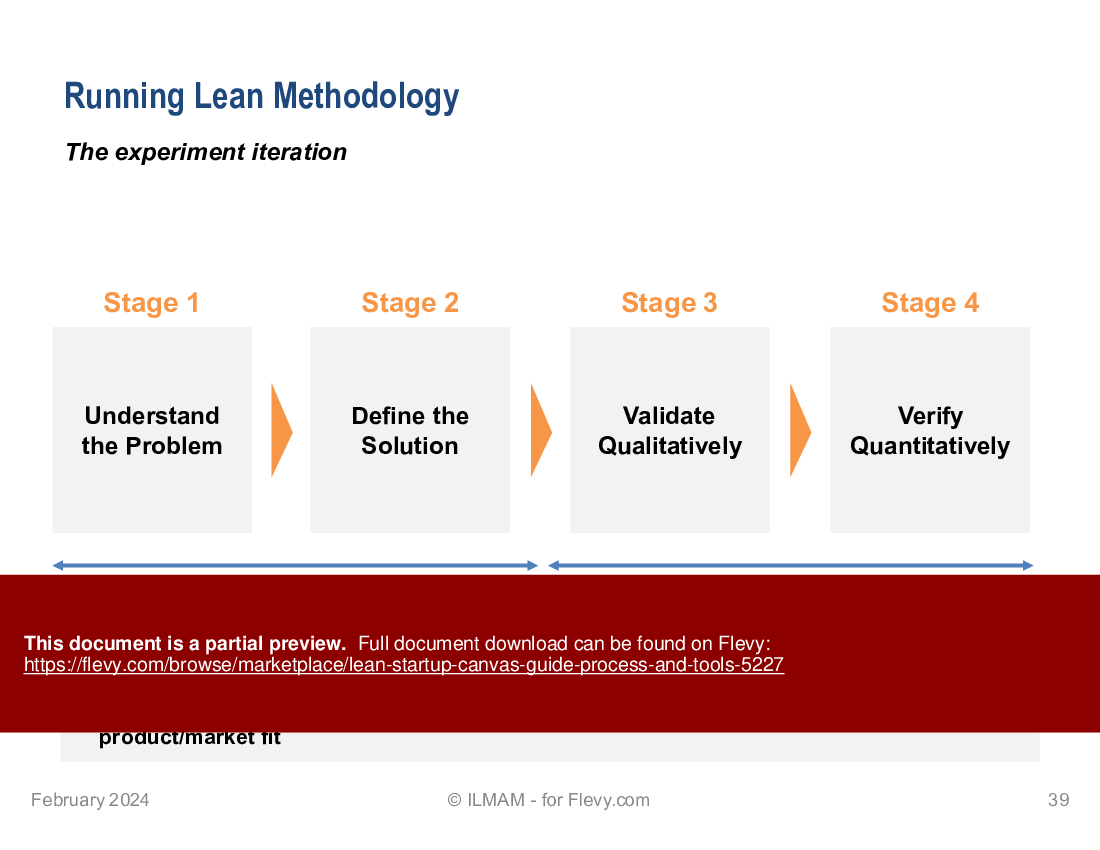Lean Startup Canvas: Guide, Process and Tools (PowerPoint PPTX Slide Deck)
PowerPoint (PPTX) 56 Slides
BENEFITS OF THIS POWERPOINT DOCUMENT
- Provides an overview of the Running Lean Methodology and the Lean Canvas
- Offers guidance on using the Running Lean methodology and Lean Canvas
- Includes tools and templates to facilitate an effective and efficient Lean Canvas exercise
ENTREPRENEURSHIP PPT DESCRIPTION
The Lean Canvas is an adaptation by Ash Maurya of the Business Model Canvas. Four building blocks were replaced with new ones with the aim of making the canvas more startup-oriented. The adaptation emphasizes importance of clearly understanding the problem the customer faces.
Beyond the canvas itself, Maurya's introduces an overall Running Lean methodology. The methodology incorporates lessons from the Steve Blank's customer development approach, which aims to learn about customers and their problems as early in the development process as possible. It also incorporates elements of Eric Ries' Lean Startup method, which calls for a scientific approach to creating and managing startups and get a desired product to customers' hands faster.
While the underlining concepts were based on IT startups, the Running Lean methodology can be applied to new products/services at a startup or at an existing company.
This document provides an overview of the Running Lean Methodology and the Lean Canvas. It offers guidance on using the Running Lean methodology and Lean Canvas and includes tools and templates to facilitate an effective and efficient Lean Canvas exercise.
Contents
1. Lean Canvas: Origins and key definitions
-Origins
-Key definitions
-Adaptations from the Business Model Canvas
-Rationale for adaptations from the Business Model Canvas
-The two sides of the canvas
2. Running Lean Methodology: Key concepts
• The three stages of a startup
-The Build-Measure-Learn feedback loop
-The Build-Measure-Learn feedback loop ? with comments
3. Running Lean Methodology: Process and workflows
-Main steps
-High level workflow
-Product/solution fit workflow
-Product launch fit workflow
-Product/market fit workflow
4. Running Lean Methodology: Document Plan A
-The nine building blocks of the canvas
-The key canvas building blocks questions
-Canvas development guidelines
-The Problem building block
-The Customer Segments building block
-The Unique Value Proposition building block
-The Solution building block
-The Channels building block
-The Revenue Streams building block
-The Cost Structure building block
-The Metrics building block
-Metrics – Dave McClure's Pirate Metrics
-The Unfair Advantage building block
5. Running Lean Methodology: Identify the riskiest parts
-Risk types
-Approach for systematically eliminating risks
-Risk sequencing
-Identified customer segment prioritization
-Crossing the chasm on the adoption curve
-Running effective business model experiments
-The experiment iteration
-Lessons learned report ? example
6. Running Lean Methodology: Systematically test the plan
-Problem interview risk elimination focus
-Problem interview falsifiable hypothesis
-Problem Interview
-Solution interview risk elimination focus
-Solution interview falsifiable hypothesis
-Solution Interview
-MVP interview risk elimination focus
-MVP interview falsifiable hypothesis
-MVP Interview
-Metrics – Dave McClure's Pirate Metrics
7. Lean Canvas: Template and graphical elements
-Blank template
-Blank template with text holders
-Sticky notes and building block graphic
This guide covers the origins and rationale behind the Lean Canvas, providing a historical context. It also details the three stages of a startup, offering actionable insights for each phase.
Got a question about the product? Email us at support@flevy.com or ask the author directly by using the "Ask the Author a Question" form. If you cannot view the preview above this document description, go here to view the large preview instead.
Source: Best Practices in Entrepreneurship, Business Model Canvas, Lean Startup PowerPoint Slides: Lean Startup Canvas: Guide, Process and Tools PowerPoint (PPTX) Presentation Slide Deck, ILMAM - Strategy & Management Consulting
ENTREPRENEURSHIP PPT SLIDES
This document is available as part of the following discounted bundle(s):
Save %!
Business Model Canvas and Lean Startup Canvas Bundle
This bundle contains 2 total documents. See all the documents to the right.















